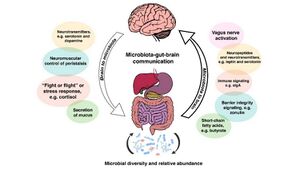The Gut Microbiome & Parkinson's disease: Difference between revisions
| Line 41: | Line 41: | ||
==Conclusion== | ==Conclusion== | ||
More and more research is being done on the gut-brain axis in relation to Parkinson’s disease, and finding ways to alter the gut microbiome to include more of the essential bacteria flora earlier can potentially hinder the pathology of PD altogether. Understanding what causes dysbiosis of the gut microbiome, which medications can alter the bacteria within the gut, and being aware of even more clinical implications such as obesity and IBS/IBD can make more researchers interested in finding a less elusive connection between the brain and gut. Device-assisted therapies are a very new mode of exploring the gut microbiome and its connection to Parkinson’s disease. More studies comparing the use of DATs to medications like L-dopa are necessary because they can help develop new treatment options for patients with PD. It is important to keep in mind that much research is yet to be done on this topic, and more is definitely coming as conventional medicine and therapies are changing as new knowledge and opinions are being formed. With the help of new research and more information being made available about the bidirectional relationship between the gut and the brain, more people are aware of the implications their gut microbiota have on their overall and even neurological health. | |||
==References== | ==References== | ||
<references /> | <references /> | ||
<br><br>Authored for BIOL 238 Microbiology, taught by [mailto:slonczewski@kenyon.edu Joan Slonczewski], 2022, [http://www.kenyon.edu/index.xml Kenyon College] | <br><br>Authored for BIOL 238 Microbiology, taught by [mailto:slonczewski@kenyon.edu Joan Slonczewski], 2022, [http://www.kenyon.edu/index.xml Kenyon College] | ||
Revision as of 23:44, 13 April 2022
Introduction to Parkinson's disease: A Gut-Brain Connection

By Ania Axas
At right is a sample image insertion. It works for any image uploaded anywhere to MicrobeWiki.
The insertion code consists of:
Double brackets: [[
Filename: Parkinsons-gut-microbiome.jpg
Thumbnail status: |thumb|
Pixel size: |300px|
Placement on page: |right|
Legend/credit: Electron micrograph of the Ebola Zaire virus. This was the first photo ever taken of the virus, on 10/13/1976. By Dr. F.A. Murphy, now at U.C. Davis, then at the CDC. Every image requires a link to the source.
Closed double brackets: ]]
Other examples:
Bold
Italic
Subscript: H2O
Superscript: Fe3+
Sample citations: [1]
[2]
A citation code consists of a hyperlinked reference within "ref" begin and end codes.
To repeat the citation for other statements, the reference needs to have a names: "<ref name=aa>"
The repeated citation works like this, with a forward slash.[1]
Dysbiosis of the Gut Microbiome
Include some current research, with at least one figure showing data.
Every point of information REQUIRES CITATION using the citation tool shown above.
The Gut Microbiome's Interactions with Parkinson's medications
Include some current research, with at least one figure showing data.
Current Research
Include some current research, with at least one figure showing data.
On the clinical side
Conclusion
More and more research is being done on the gut-brain axis in relation to Parkinson’s disease, and finding ways to alter the gut microbiome to include more of the essential bacteria flora earlier can potentially hinder the pathology of PD altogether. Understanding what causes dysbiosis of the gut microbiome, which medications can alter the bacteria within the gut, and being aware of even more clinical implications such as obesity and IBS/IBD can make more researchers interested in finding a less elusive connection between the brain and gut. Device-assisted therapies are a very new mode of exploring the gut microbiome and its connection to Parkinson’s disease. More studies comparing the use of DATs to medications like L-dopa are necessary because they can help develop new treatment options for patients with PD. It is important to keep in mind that much research is yet to be done on this topic, and more is definitely coming as conventional medicine and therapies are changing as new knowledge and opinions are being formed. With the help of new research and more information being made available about the bidirectional relationship between the gut and the brain, more people are aware of the implications their gut microbiota have on their overall and even neurological health.
References
Authored for BIOL 238 Microbiology, taught by Joan Slonczewski, 2022, Kenyon College
